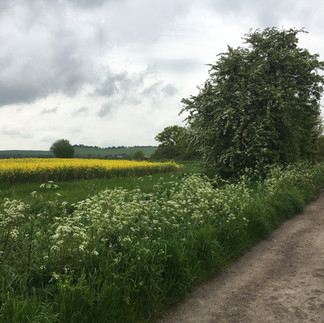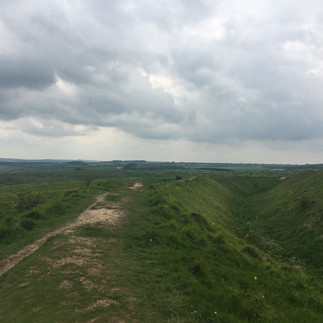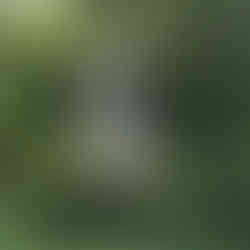
This ploughman dead in battle slept out of doors
Many a frosty night, and merrily
Answered staid drinkers, good bedmen, and all bores:
"At Mrs Greenland's Hawthorn Bush," said he,
"I slept." None knew which bush. Above the town,
Beyond "The Drover", a hundred spot the down
In Wiltshire. And where now at last he sleeps
More sound in France - that, too, he secret keeps.
Edward Thomas wrote A Private in January 1915, an early poem and, like other early poems, it drew on his memories as he was stuck at home with his badly sprained ankle. In its 8 lines he packed a lot in. The recollection was from May 1912 when he was on a long walk in Wiltshire starting at Chiseldon outside Swindon, the first two days of which are recorded in detail in his field note book (no.54). Wiltshire was a county he knew very well - he has spent much time there in his childhood on summer holidays staying with relatives, and later it was the location for an important time in his courtship of Helen, staying with his old childhood friend and mentor of the natural world, Dad Uzzel. Some have said it was his favourite county.
On one of the early pages of the FNB, noted down as a separate item before he began describing his walk, is the following: 'hardy drinker sleeping out in hoar frosty n(igh)t says he stayed at "Mrs Greenland's Hawthorn Bush"'. This anecdote probably came from listening to a conversation in a pub, something of a pastime for ET, perhaps before he set out from Chiseldon. There are a number of pubs in the immediate vicinity - but there is no reference that I can find to The Drover , though a number of Wiltshire pubs are known historically to have been droving pubs. An answer to its whereabouts may lie in ET's habit of anonymising and even fictionalising some of the places in his writing.
In his book, The Icknield Way, he described his journey from Thetford to Wanborough just to the east of Swindon along the ancient way which partnered and indeed occasionally joined the Ridgeway for much of its journey. At Wallingford he was reminded of a fictitious town called Coldiston, at the edge of which is a public house called "The Jolly Drover"' whose small back windows look "over a windy common to noble hills". This pub has a tap room that "is the one blot upon the face of Coldiston" which is otherwise "clean and demure".
ET seems to have resurrected the Jolly Drover again in A Private though the drinkers in the poem are staid and boring, not something the locals at the tap at Coldiston could be accused of!
So where might have been the actual pub ET heard about the hardy drinker sleeping under Mrs Greenland's Hawthorn Bush?
He mentioned two local pubs he knew well in the vicinity in the first chapter of his biography of Richard Jefferies, who had been born and spent his childhood near Chiseldon at Coate Farm and was a major influence on ET's country writing. The first was the Bull at Broad Hinton and the second The Plough on the Marlborough Road between Swindon and Chiseldon opposite the turning to Badbury. He also wrote in The Icknield Way of The Shepherd's Rest on the Ridgeway east of Liddington Castle which was an old drover's inn.

The most likely candidate is The Plough given its location close to the beginning of the walk. It was established with its own home brewery in 1870, is now the Plough on the Hill, an elision for what used to be called The Plough on Plough Hill. It is within sight of one of the great ancient neolithic forts of the Wiltshire Ridgeway, Liddington Castle, which was a favourite haunt of both ET and his hero, Richard Jefferies. The hill is garlanded with thorn bushes above its bare grassy flanks, and the thorn can also be seen climbing its slope on the line of the horizon. Does ET's ploughman sleeping on the Downs link to the inn on Plough Hill, another play on words alongside the joke within the poem that the drinker talks of Mrs Greenland's Hawthorn Bush as if it was a pub? There is no reference in the field note books to the hardy drinker being a ploughman - indeed a first draft of the poem has the hardy drinker as just a labouring man - and of course as he was hearing this story over two years before the war, nor is he a private, dead in France.

So where was the site of the ploughman's slumbers in Wiltshire under a hawthorn tree? Liddington Castle seemed a possibility until coming across the following passage in the field note book 54. As ET made his way along the Ridgeway track on that first day, approaching Barbury Castle from below he wrote: "again hedges open apart & the mead is big & sloping w(ith) many fine hawthorns (a score or more, fifty perhaps) scattered ab(ou)t (Mrs Greenlands Hawthorn Bush)." He goes on "the big one ab(ou)t 9ft girth - thorns usually divide with 2 or 3 big limbs abt 4 feet up & are clear of leaves to ab(ou)t same height or more. R(oa)d quite unmarked underfoot but can be seen 100 yds ahead going to N side of Barbury."
So the sloping fields of Burderop Down and below Barbury Castle, a few miles South and West from Liddington on a westward curve of the Downs, was where ET had in mind for the location of the sleeping ploughman. There are less thorns on these hills than in ET's day though there are still a few going up either side of the old Swindon-Marlborough road (really a narrow lane), called Ladder Hill, which climbs the hill to the left of Barbury.

Just after this observation "when the hedges (on either side of Ridgeway) narrow in again" he spotted a ploughing team - "2 teams of 4 Red Devon oxen ploughing very slow & gazing ab(ou)t at each step & whisking tails....a small boy ploughs w(ith) one team. The 2 leaders enormous smooth sided beasts. The ploughboy w(ith) whip touches them up now & then & calls them by their names, blinkered of course".
Recalling these passages from his FNB, ET seems to have added two separate components together - the story of the hardy drinker sleeping under Mrs Greenland's Hawthorn Bush and the plough teams he encountered below Barbury Castle - combined possibly with the location of The Plough on Plough Hill and brought up-to-date in 1915 with his acute awareness of the ravages of war decimating rural workers. As a result he turned an amusing pub anecdote into a poignant tale of the merry ploughman who joined up, went to France and was now presumed dead, and so created his first direct war poem - one of only a very few - all in eight lines.
A walk
ET's field notebook 54 is unusual in a number of ways. The bulk of it covered just two days and described his walk in a lot of detail from Chiseldon south of Swindon to the northern borders of Salisbury Plain over the Marlborough Downs, past Avebury and across Pewsey Vale. It was also written in the form of a guide so there are a number of variations of "here you will see this", an unusual style for ET in his FNBs. Was he considering developing this into some form of published guide? It might have been notes for a sequel to the journey in The Icknield Way which ended at Wanborough, the next door village to Chiseldon where his walk began in the FNB 54. FNB55 continued the journey through Wiltshire to Salisbury. Whatever the original motivation the FNB 54 certainly provided him with a lot of material for later use in his poems - not only is it the source of A Private but further on there is much that relates to the early stanzas of Lob as well as A Gentleman.
So it is possible to identify very precisely where ET walked during these days and to follow in his footsteps. As touched on earlier it was countryside he had known very well from childhood. For a really fine description of the whole countryside south of Swindon you can still do no better than read the first chapter of Edward Thomas's biography of Richard Jefferies - the Country of Richard Jefferies.

The walk starts on the Ridgeway, not the long distance airy path that follows the tops of the Wiltshire Downs, but as ET described in The Icknield Way from the base of Liddington Castle "a road going straight across the low land to Barbury, mounting the hill on the north side of that camp..." This Ridgeway path is sometimes called the Old Ridgeway. It is now a modern road/lane before arriving beyond Chiseldon at Buff cottages where it becomes a track which winds towards Burderop Down and the clump on the top of Barbury Castle, a couple of miles south and west.
This is wide country with long distance views of the hills and the plain which reminded ET (and Richard Jefferies previously) of the sea. ET writes "The eye somehow expects it. There is something oceanic in their magnitude, their ease, their solitude, above all, in their liquid forms, that combine apparent mobility with placidity, and in the vast playground which they provide for the shadows of clouds." This certainly still feels true of the country bordered by Liddington Castle and Whitefield Hill to the East and the southern wall stretching from Coombe Down above Ogbourne St George along Smeathe's Ridge which joins up with the lower line of Burderop Down before proceeding west to Barbury Castle. ET goes on; "When they (the hills) do not curve, they make that almost straight horizontal line, which seen five or six miles off against a pale evening sky through clear or misty air, is so significant and so untranslatable...They have a hugeness of undivided surface for which there is no comparison to be found on the earth, and but seldom in the sky."
Closer to, ET noticed that the Ridgeway 'winds w'out reason' and speculated whether this was because it was an ancient track "... originally thru wood...where way w(oul)d not be as clear as now."

On a late May day the hawthorn is mainly in blossom and its trees and bushes are evident at every turn. The hawthorn, or May, has been venerated since ancient times with its flowering celebrated as a culmination of spring and the beginning of summer. Inevitably superstitions have attached to it - in particular a taboo to bringing it inside a home because it presages a death. This superstition would have been known to ET - was his ploughman presaging his own death by sleeping under it, albeit in the open air?
On the elder, blossom is beginning to show, with the smell of its leaves which ET described as "like food" - a much boiled vegetable at a Victorian institution maybe! In late May the beech and oak trees are well in leaf but ash leaves are only just beginning to appear.
Chaffinches are in fine voice as are charms of chattering goldfinches. A blackcap, "the king of the warblers" sings its song, which Gilbert White, the naturalist, described as a "full, sweet, deep, loud and wild pipe". Maybe ET heard its ancestor in a blackthorn copse "w(ith) blackcap & whitethroat tossed in the air". Further on he smelt the crab (apple) tree blossom "purest of faint scents" and saw a slightly curved field which, bizarrely he wrote of "only genus locii is exploring"!

The Old Ridgeway crosses the old Swindon/Marlborough road below Ladder Hill and begins to climb slowly up the hill beneath the camp - as ET wrote "in no hurry to reach the ridge". Looking back one can see the curve of Liddington Hill still clear but gradually diminishing. Rounding the corner the track meets the road to Wroughton and you follow the road a few yards up to the entrance to Barbury Castle, where you join the modern Ridgeway path.
The earthworks are impressive with deep trenches and the beech clump in the background. As you walk on top of the inner wall towards the clump, Liddington Hill can be seen clearly in the distance. ET thought he could see beyond to White Horse Hill above Uffington despite a haze in that direction.

This is an ancient landscape - of forts and tumuli, ancient fields and sarsen stones. A battle was fought here in 556 which is marked up on the map ET would have used, whose site he wrote was "in cornfield W(est) of rookery". He also wrote of "earthworks against Cerdic", a leader of the West Saxons dead some years before the battle when his Saxons prevailed against the Britons.
From Barbury Castle looking south ET wrote "you see a world of lesser Downs & beyond them the grey mass of Savernake & the abrupt bulk of Martinsell". The view is more or less unchanged today - in contrast to the north where the enclosed and subdivided fields between hedgerows and trees of ET's day have been merged into larger fields and the corn has been replaced by uniform bright yellow rape.
The top of Barbury has always been associated with horse racing - point-to-points are still held there in a natural amphitheatre just to the south of Barbury Castle. On the other side ET identified on his way up to Barbury a "long green width, over a mile of it, used for steeplechase, with made hedges and beautiful yet? bushy hawthorns standing out in middle".
Along the ridge leading back to the car park for Barbury Camp there are a number of fine ancient hawthorns - some of which would make good camps for a tired ploughman. At the lane at the end, the top of Ladder Hill, a quick detour is recommended to the right, to see the wonderful stretch of downland - Smeathe's Ridge - its wide green back stretching east to Coombe Down above Ogbourne St George.

Retracing your steps, you go down Ladder Hill and take a right through a farm gate along a track that crosses Burderop Down. Here are more solitary hawthorns of some character
and a stone that memorialises Richard Jefferies. Its quote "It is eternity now. I am in the midst of it. It is about me in the sunshine" comes from his wonderful autobiography The Story of my Heart which ET admired hugely calling the book "a poem. Almost a piece of music" - from ET, the critic, the very highest praise.
The track gradually takes you down Burderop Hill with long distance views of Liddington Castle and the southern sweep of the Wiltshire Downs, past a shooting school, the sound of whose shots may have punctuated your walk. Towards the bottom, as views of Coombe Down open up to the south, to the left there is the outline of a large tumulus scattered with hawthorn bushes. Here you sense strongly the link between the ancient people and their beliefs and the hawthorn bush. The proprietress of the hawthorn bush, Mrs Greenland is a sort of green matriarch, the female equivalent to the green man or a Puck or Lob. ET found Wiltshire a fertile ground for imagining these mainstays of English folklore and the ancient countryside - probably in part because of the character of David ('Dad') Uzzell, his childhood friend and mentor. From the FNB it is clear much of the inspiration for his later poem Lob stems from the Ridgeway south of Avebury.
Beyond the tumulus and along the track, close set with hawthorn and elder, you arrive at a cross path. The continuation of the track is Gypsy Lane, an ancient way that has tumuli on either side, will eventually take you to the top of Whitefield Hill and the modern Ridgeway track from whence you can reach Liddington Castle. To get back to the Old Ridgeway, you take the path on your left and going round the shooting school you take the track north past some sycamore trees and a stray sarsen, which joins up with the Old Ridgeway. Turning right you follow it back to your start.
Map/coordinates etc
Best map for the walk along this section of the Ridgeway is OS Landranger 173 Swindon & Devizes or OS Explorer 157 - Marlborough & Savernake Forest.
Barbury Castle grid reference SU149762 - Postcode SN4 0QH
Liddington Castle grid reference SU209797 - Postcode SN3 6AA
A good guide to walking on and around The Ridgeway can be found on the National Trails website;
https://www.nationaltrail.co.uk/en_GB/trails/the-ridgeway/
Sources of quotes/references
FNB 54 Field Note Books - copyright Henry W. and Albert A. Berg Collection, New York
Richard Jefferies by Edward Thomas
The Icknield Way by Edward Thomas

- it would be interesting to hear if others are able to match it more precislely






























ความคิดเห็น